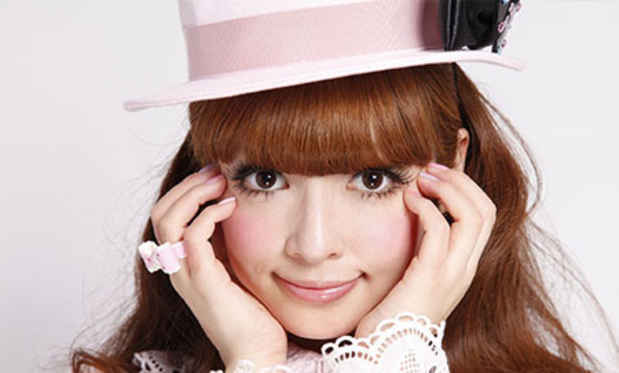“Lolita Fashion: Costume or Culture?” Show
Japan Society Gallery

This event has ended.
From Sweet, Classic Pink to Gothic and Punk Chic, Expert Panel Examines the Origins and Global Phenomenon of Japan’s ‘Lolita’ Style
** Featuring Misako Aoki + Mini Fashion Show **
Japan’s inimitable Lolita fashion trend took off from the streets of Harajuku in the 90s and has proved a lasting global phenomenon. The avant-garde, self- and tailor-made take on Victorian-era clothing has created a vibrant subculture. Twirling its Rococo skirts and accoutrements in many directions, styles range from brooding gothic blacks and punk Westwoodian tartans, to sweet and kawaii (or cute) bursts of pink flowers and bows—all ornate, opulent, frilly and thrilling.
In Lolita Fashion: Costume or Culture?, an expert panel goes behind the seams of Lolita fashion, delving into the origins, history, styles, international permutations, and what’s new and on the horizon. Gwynn Galitzer, performance artist and Founder of Dirty Bird Productions, moderates the panel featuring Japan’s former “Kawaii Ambassador” Misako Aoki, appointed by the Ministry of Foreign Affairs of Japan in 2009; Carolyn Dee, author of the popular Lolita blog F Yeah Lolita and administrator of the largest English-speaking Lolita online community, and Christina Gleason, researcher of Lolita culture, author of the blog Ramble Rori, and founder of the first Northeast USA alternative fashion conference, RuffleCon.
In addition, Baby, the Stars Shine Bright, which was established in 1988 by Akinori and Fumiyo Isobe in Tokyo, Japan and now has 28 shops across Japan with flagship stores in both Paris and San Francisco, will show a collection of Lolita fashions direct from Japan chosen specifically for this event.
The New York Times described Lolita fashion as its second decade of existence came to a close: “skirts with petticoats, baby-doll dresses, bloomers, corsets and high-necked, ruffled shirts are all part of the style, and no look is complete without a parasol, a headdress, a handbag or the perfect pair of Mary Janes. Fine lace and demure cuts emphasize the overarching preference for modesty. For many young women, being a Lolita is more than a way of dress. It is a state of mind, a way to live even when not dressed as a Lolita.”
More recently, CNN commented on the deeper psychological context of Lolita: “Some fans of the fashion believe that it is a direct commentary on the oversexualization of the female image, and by taking it in a new direction, lolitas challenge the image of what women are supposed to look like. Some believe it makes them less approachable, creating a wall of safety between themselves and men who might otherwise approach them. Some enjoy the idea of looking doll-like and simply enjoy the fashion for what it is, and like wearing it out in public gatherings.”
PANELISTS
Misako Aoki is a top model for Baby, The Stars Shine Bright; Putumayo; Algonquins; and other well-known Japanese gothic and Lolita fashion brands. She has graced the pages of the leading Harajuku magazine, KERA. In her role as an official “Kawaii Ambassador” (i.e. Ambassador of Cute) for the Japanese Government, she traveled the world to help develop appreciation of Japanese fashion and pop culture. Aoki is a President of the Japan Lolita Association, established in 2013, which boasted more than 3,000 members in less than a year, with more than half from foreign countries, according to the Nikkei Voice. While active in the Japanese fashion scene, Aoki works to advance social welfare in her primary job as a registered nurse.
Being involved with Lolita fashion for over a decade, Carolyn Dee runs the popular Lolita blog, F Yeah Lolita. She is also admin of the largest English speaking Lolita online community, and was a co-creator of RuffleCon. More at fyeahlolita.blogspot.com.
Christina Gleason has researched Lolita fashion and its sub-culture through informal surveys and interviews on her blog, Ramble Rori. Since then, she has given over 40 presentations, been sourced in research papers, and created the first Northeast USA alternative fashion conference, RuffleCon.
Gwynn Galitzer (Moderator) is a performance artist born and raised in New York City’s Hell’s Kitchen. She holds a BFA degree from the School of Visual Arts, where she received the 2010 Rhodes Family Award in Fine Arts and the BFA Fine Art Thesis Grant. She has exhibited and performed at Envoy Enterprises, Dixon Place, The Wild Project, and the 2011 Creative Time Gala among other venues and galleries. From 2009-2012 Gwynn was the Co-Director of The Lowbrow Society for the Arts, a New York City based artists collective, where she produced and curated art shows and interactive installations at 950 Hart Gallery, DROM, Rebel NYC, Brooklyn Fire Proof, and The Gowanus Ballroom. In 2012 Gwynn founded Dirty Bird Productions, a network of DIY musicians, artists, and writers dedicated to building a strong, supportive community that benefits the whole, as well as the individual. She is currently producing, promoting, and directing shows with Dirty Bird Productions in Brooklyn
Media
Schedule
February 05, 2014
Opening Reception on 2014-02-05 from 18:30
The event will be followed by a meet-and-greet wine reception hosted by Misako Aoki.